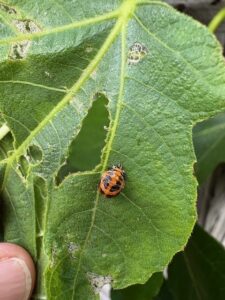19 June 2025
Customer Question – What are these?
Q. “These are the photos I spoke to you about. What are they? Should I be squashing them?” from Graham


A.Thanks for the pictures and these are Harlequin Ladybird Larvae and pupa. Harlequins are an invasive non-native species, which are now very common and will be attracted to your aphids, so these (which are harlequins) are naturally occurring. At this time of year they are a welcome site because they will eat lots of aphids and only become a problem when food is scarce. The RHS advice is to leave them alone and let them eat your aphids.
The Harlequin is becoming a problem because of its size, its voracious appetite (including beneficial insects) and its ability to breed throughout the spring, summer and autumn. The Harlequin Ladybird was introduced from Asia to North America in the 1980s to control aphids in crops and quickly spread across the United States. It was then introduced into Europe to control aphids in the same way before arriving in Britain in 2004 – possibly blown over by strong winds. Like other ladybirds, the Harlequin eats aphids and this was the reason why it was introduced into food crops, BUT unlike other ladybirds, once the aphids have run out it will then start feeding on the eggs of caterpillars, moths and butterflies PLUS it will even attack the eggs and larvae of our NATIVE ladybirds. The main reason Harlequin ladybirds pose a threat to our native ladybirds is that they can easily out-compete our native ladybirds for food and then once that food runs out they will eat our ladybirds as well. The Harlequin Ladybird is here to stay and with no means of controlling harlequin ladybirds, without harming our native ladybirds it is important to encourage our NATIVE ladybirds – we have NATIVE Ladybirds available for release in your garden to boost their number.
Harlequin ladybirds vary enormously in appearance, which can make them difficult to tell apart from our native ladybirds. Harlequins are larger than our native ladybirds and can be up to 1cm in length – if a ladybird is less than 5mm then it is NOT a harlequin. The 2 most common colourings for Harlequins are orange with 21 black spots or black with two red spots – not to be confused with the melanic form of the 2-spot ladybird, which we supply, which is black with four or six red spots! The larvae are much larger as well reaching up to about 1cm in length, have two orange stripes and are spikey. The only native ladybird which is similar in size to a Harlequin Ladybird is the 7-spot Ladybird, but only the 7 spot ladybird has exactly 7 spots! In summary, Harlequin Ladybirds can be red, orange or black and will have between 0 – 21 spot. It will also have brown legs.

Available to buy now
Adult Ladybirds x25
Buy Adult Ladybirds for Your Garden Ladybirds are a welcome sight in the garden, where they happily munch away on…
Ladybird Larvae x50
Control pests like aphids (greenfly and blackfly) naturally by releasing Ladybird larvae. Ladybird Larvae have a huge appetite for soft-bodied…
British Ladybird Larvae x100 with Release Bags
Aphids attacking trees can be a BIG problem (the 1st visible symptom of attack is large amounts of sticky honeydew which drips down on to…
